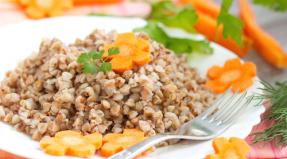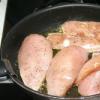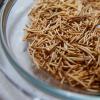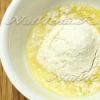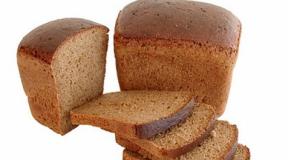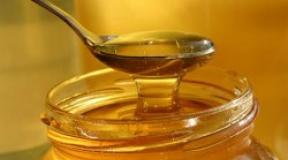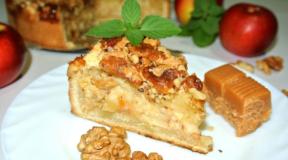Coursework: Raw materials for the production of grape wines. Chemical composition of grape wines
Grape wine is a complex colloidal product consisting of water, alcohol, sugars, acids, protein, tannins, coloring, aromatic and mineral substances, as well as vitamins. Natural (table) grape wine retains almost all the constituent substances contained in fresh grapes.
largest specific gravity in grape wine, water accounts for 860-940 g/l, or 86-94%. The amount of alcohol varies depending on the brand of wine. In table wines it is up to 14%, in strong wines - up to 20, dessert - up to 16, sparkling - up to 12.5% vol.
Carbohydrates are represented mainly by glucose, fructose, sucrose, pentose; in dry wines they are from 0.1 to 0.25% (traces), strong - from 0.2 to 1.0, in semi-sweet and sweet - from 3 to 20, in liqueur wines - more than 20%. The great value of carbohydrates grape wines are their high calorie content and easy digestibility by the human body. 100 g of dessert wine contains up to 80 calories. Approximately the same number of calories contains 50 g of bread, 150 g of milk, 100 g of potatoes, 200 g of pears.
Of the organic acids, tartaric, malic, citric, succinic, lactic and acetic acids predominate. Acidity is determined by the content of titratable acid in grams per liter of wine (ppm) and can range from 2.5 to 9 g/l. Organic acids of grape wines stimulate many processes in the body; promote digestion, facilitate the action of pepsin.
Tannins range from traces in white wines to 4 g/l in red wines. They are very active biologically, have the properties of vitamin P and have beneficial influence on the walls blood vessels by strengthening them.
The dyes that pass into the wine from the grapes give it a natural color from almost colorless greenish to ruby and garnet.
aromatics, or essential oils grapes. In wine, the aroma introduced by the grape variety is distinguished, and the bouquet is a complex of odorous substances (higher alcohols, esters, aldehydes, acetals, vanillin) formed during the aging and processing of wines.
Vitamins are a biocatalyst. Of the water-soluble vitamins in wine, there is vitamin C (up to 15 mg / l), a group of vitamins B is widely represented, as well as nicotinic acid.
Mineral substances of grape wines are represented by potassium, magnesium, calcium, phosphorus, sodium, iron, manganese, chlorine, iodine, copper. Dessert wines of the southern coast of Crimea are rich in colloids (proteins, polysaccharides, etc.).
Due to this chemical composition, grape wine has potential energy, almost completely used human body. One liter of dry natural wine gives from 600 to 750 calories, a liter of port wine - 1200, a liter of dessert wine - up to 1500 calories. Microelements contained in grape wine are catalysts (accelerators) and regulators of metabolism in the human body. A favorable combination of alcohol, organic acids, sugar, various minerals in wine makes wine a strong bioenergy drink.
Grape wine is a complex colloidal product consisting of many organic substances: water, sugar, alcohol, vitamins, tannic, protein, coloring acids, mineral and aromatic components. If the production technology is followed, all the useful substances of fresh berries are preserved in the composition of the wine.
The largest share falls on water, its percentage varies from 86% to 94%. Next comes alcohol, its concentration depends on the brand of wine. Table wines have an alcohol content of 14%, for fortified wines - up to 20%, dessert - 16%. Sparkling wines (champagne) have the smallest strength - up to 12.5%.
Carbohydrates in the composition of wine are represented by sucrose, pentose, glucose and fructose. They are easily absorbed by the body, positively affecting the processes of digestion and the cardiovascular system.
Among the organic acids in wine, lactic, citric, malic, acetic and succinic acids predominate. The acidity of wine is measured in ppm. An indicator of 2.5 to 9 g / l (grams per liter) is considered normal. In the chemical examination of the quality of wine, first of all, its acidity is measured. Deviation from the norm is indisputable evidence of poor quality.
Biologically active are tannins, which are also found in the chemical composition of wine. They have all the positive properties of vitamin P and strengthen the walls of blood vessels. Moreover, in enough tannins are present only in red wines, where their concentration reaches 4 g/l. In white varieties, their concentration is minimal.
The dyes that pass into the wine from natural grapes give the drink its color. The color of the wine ranges from colorless greenish to dark garnet.
The composition of aromatic substances (essential oils) contained in wine depends on the grape variety. In turn, the aromatic bouquet is formed during the processing and aging of wines. The aroma is created by tannins, aldehydes, esters and vanillin. Their concentration in the bottle finally forms the smell of the drink.
 The aroma of wine depends on the processing of the grapes.
The aroma of wine depends on the processing of the grapes. Of the water-soluble vitamins, wine contains vitamins of groups B and C, as well as nicotinic acid. These are biological catalysts necessary for the normal functioning of the body. They contribute to normal metabolism and help to cope with infections. Therefore, in moderation, the benefits of wine are undeniable.
In the composition of grape wines, minerals are represented by iron, manganese, chlorine, magnesium, manganese, phosphorus, sodium, iodine and copper. These elements are also indispensable for the normal functioning of the body.
By chemical indicators grape wines must meet the requirements of GOST 7208-93.(6)
The chemical composition of wine is very complex: apart from ethyl alcohol, sugars and organic acids, it contains tannic, aromatic, coloring and mineral substances, vitamins. (14)
1. Alcohols.
Ethanol (E) is the main product of alcoholic fermentation. It determines the toxic, additive, caloric properties of wine and other alcoholic beverages. It has been established that E moderate doses It has anti-stress, cardioprotective and radioprotective effects. The calorie content of table dry wine (570-980 kcal/l) is almost completely provided by the oxidation of E. Methanol is spontaneously formed in the process of enzymatic transformations of pectins. Especially a lot of it in red wines prepared in the Kakhetian way. The methanol content in white wines usually ranges from 20 to 100 mg/l, and in red wines from 80 to 350 mg/l.
Aliphatic monohydric alcohols (AOS) - propyl, butyl, isobutyl, amyl, isoamyl, hexyl, etc. - are products of yeast metabolism. 20-40% of AOC in wines are represented by isoamyl and isobutyl alcohols. The content of AOC in white wines is 150-400 mg/l, in red wines - 300-600 mg/l. In not large quantities they form the aroma of wines, and in large ones they worsen their organoleptic properties.
Aliphatic unsaturated alcohols (0.5-8.0 mg/l), represented by terpene alcohols (geraniol, linaliol, citronellol, etc.), and aromatic alcohols (about 1 mg/l), represented mainly by phenylethyl alcohol, determine aromatic properties wines
All alcohols in quantities determined in wine are safe in terms of toxicological and nutritional value, with the exception of glycerin.
Fatty aldehydes in wines are 90% acetic and 10% propionaldehyde. Wines that have not been treated with sulfur dioxide contain 30 to 50 mg/l of acetaldehyde, while those that have been treated contain up to 200 mg/l. The content of acetaldehyde increases during sherrying (up to 600 mg/l), aging, aeration of wines and the action of foreign microflora. In large quantities, it imparts a hint of an old, smooth wine and is one of the main factors that determine the taste of marsala-type wines. Due to the high reactivity, aldehydes condense with substances containing an amino group to form melanoids, are reduced to the corresponding alcohols, and interact with other fermentation products. The content of furan aldehydes (furfural, hydroxymethylfurfural and methylfurfural) in wines does not exceed 30 mg/l.
Ketones (acetone, diacetyl, 2-butanone, 2-pentanone and butyrolactone) are present in trace amounts in wine. Only acetone is determined in concentrations of 3-30 mg/l. Aldehydes and ketones do not affect the toxic and nutritional properties of wine.(15)
2. Esters, acetals, waxes and oils.
Aromatic substances take part in creating the aroma and bouquet of wine. They get into it from grapes in the form of essential oils and other compounds, are formed during fermentation, during processing, and during long-term aging, a bouquet of wine is formed. (13)
Content of ethyl esters fatty acids in wine it is usually 50-200 mg / l, ethyl esters of hydroxy acids - 100-500 mg / l. Ethyl acetate predominates (20-200 mg/l). During long-term aging, the acid esters of tartaric, malic and succinic acids accumulate in the wines. Maximum content esters determined in sherry (up to 1000 mg/l). Most esters have a pleasant fruity scent. It has been established that enanthic ester significantly improves, and esters of acetic, butyric and valeric acids worsen the organoleptic properties of wine.
Acetals, products of the interaction of aldehydes with alcohols, are found in wines in an amount of 1-20 mg/l. The main representative - diethyl acetal - has a pleasant fruity aroma. Waxes and oils are present in wine in trace amounts. All these compounds have low toxicity and do not affect the nutritional value of wine.(15)
3. Carbohydrates.
The main monosaccharides of grapes - glucose and fructose - are almost completely utilized by yeast cells during the preparation of dry wines. Sucrose is usually converted to invert sugar. In addition to hexoses, L-arabinose (500-1260 mg/l), traces of other pentoses and polysaccharides are found in wines. The latter include pectin substances, the content of which reaches 800 mg / l with a daily requirement of 15-16 g. This does not allow them to be classified as compounds that determine the detoxification and radioprotective properties of wine. The carbohydrates in fortified wines can provide more than 50% of their calories.(15)
4. Organic acids.
Organic acids are contained in amounts from 4 g/l to 8 g/l. They are represented by malic, citric, succinic, lactic, acetic and other acids (13).
Wine acids are partly supplied to them from grapes and partly formed during the fermentation process as intermediates in yeast metabolism. From aliphatic monocarboxylic acids to largest quantities acetic (400-1500 mg/l), formic (20-100 mg/l), propionic (10-150 mg/l), isobutyric (30-100 mg/l), isovaleric (30-100 mg/l) , caproic (10-100 mg/l), caprylic (10-150 mg/l) and capric (10-150 mg/l) acids.
Of the aliphatic polycarboxylic acids, oxalic (up to 150 mg/l) and succinic (250-1500 mg/l) are present. Aliphatic monocarboxylic hydroxy acids are represented mainly by lactic (500-5000 mg/l) and gluconic (up to 120 mg/l) acids. Among aliphatic polycarboxylic hydroxy acids, the central place belongs to tartaric (1500-5000 mg/l) and malic (10-5000 mg/l). Others (methyl-apple, slime, sugar and lemon) are found in small or trace amounts.
Aldehydo- and keto acids (glyoxylic, glucuronic, galacturonic, pyruvic and alpha-ketoglutaric) are present in wine in an amount not exceeding 1000 mg/l.
Aromatic acids of the benzoic and cinnamon series (p-hydroxybenzoic, protocatechin, vanillic, gallic, lilac, salicylic, etc.) are typical primarily for red wines (50-100 mg/l). In white wines, they are significantly less (1-5 mg/l). Most of these acids have a phenol radical and, accordingly, can be assigned to the class of phenolic acids.
The active acidity of wines (pH) usually ranges from 3.0-4.2, and the titratable acidity is 5-7 g/l in terms of the strongest acid - tartaric. Organic acids are mainly in a bound or semi-bound state. They determine the bactericidal, taste and aromatic properties of wine. There are no specific data on the nutritional value of wine acids. However, given the high biological activity of some of them, it can be assumed that organic acids can make a certain contribution to the nutritional properties of wines.(15)
Wines contain little nitrogenous compounds - from 70 to 780 mg/l. 55% of all nitrogen is in polypeptides, 25 to 40% is in free amino acids, and only 3% is in proteins from grape skins. The amino acid proline stands out from the compounds of this class, the content of which in wine reaches 150 mg/l. Nitrogen-containing substances are a necessary nutrient medium for yeast and a substrate for the synthesis of aldehydes. They and the products of their interaction affect the color, aroma, taste and stability of wines. nutritional value do not represent.(15)
6. Mineral compounds.
Minerals are contained in wines in amounts ranging from 1 to 10 g/l (13).
The content of mineral substances (MV) in wines varies greatly depending on the grape variety, soil composition, climatic conditions, etc. MV are present in wine in organic and inorganic form. Potassium, calcium, sodium and iron are partially utilized by yeast cells. Aluminum, copper, lead and tin interact with sulfates by 80-90% and precipitate. Zinc, manganese, lead, copper and cobalt are included in the yeast enzyme complexes and, as they die, also precipitate. Potassium precipitates in the form of tartar. The decrease in the amount of MW continues during the processing and aging of wine materials.
The systematic consumption of 0.5 liters of wine per day allows for 5-20% to meet the daily requirement of an adult for MW. The exceptions are iodine and fluorine, the intake of which with wine can fully satisfy a person's needs for these microelements. (15)
7. Vitamins and vitamin-like substances.
Vitamins are found in relatively small amounts. In grapes, only vitamins C, P and lyositol can provide a person's need. (13)
All the vitamins present in wine come from grapes. During fermentation, a significant part of them is accumulated by yeast. Therefore, young wine is significantly depleted in vitamins. As the wine ages and the yeast cells autolyse, the vitamins are gradually released and re-introduced into the wine. During fermentation, ascorbic acid and thiamine almost completely disappear. Part of the vitamins is lost during the processing and storage of wine.
8. Phenolic compounds.
Phenolic compounds (PC) in wines are represented mainly by flavonoids, which include phenolic acids, flavonols, catechins, leucoanthocyanidins and anthocyanidins. The products of polymerization of catechins and leucoanthocyanidins are usually called tannins, which are included in the broader concept of tannins. Especially a lot of FS passes from grapes to wines made in the Kakhetian way. The total content of PS in wine reaches 6 g/l.
Wine PSs have very low toxicity and, according to modern concepts, are extremely important biologically active substances. Flavonoids determine the P-vitamin activity of wines. A number of PS, which are part of the wines, have antihypoxic, antihypertensive, anti-inflammatory, antiallergic, cardio- and hepatoprotective, hypolipidemic, antitumor and radioprotective effects. Suffice it to say that flavonoids are considered as the most promising compounds for the creation of highly effective polyfunctional drugs. A wide range of their biological activity is due to the regulatory effect on the activity of a number of enzyme complexes, as well as the ability to provide antioxidant and membrane stabilizing effects.
It has been shown that the content of flavonoids in red wine is 20 times higher than their content in white wine. Despite the wide distribution of PS in the plant world, wine can act as their main source for humans. These compounds include trioxystilbene - resveratrol. It is synthesized during the fermentation of red wine by the yeast cells of Vitis vinifera. According to the results of recent experimental studies, resveratrol is given a central place in the implementation positive influence guilt on human health.
Dissolved gases in wines include carbon dioxide and sulfur dioxide. Carbon dioxide is produced in significant quantities. Most of it dissipates in the air, and a smaller part dissolves in wine, forming carbonic acid (up to 5 g / l in sparkling wines). Sulfur dioxide enters wine from grapes and is used as food additive with antimicrobial and antioxidant activity. Its content is limited: in red wines - 175 mg / l, and in white - 225 mg / l (13)
Laboratory research of wine consists of determining the titratable acidity and the quantitative content of oxalic acid, methyl alcohol and sugar.(10)
A lot of scientific works have been written about the beneficial properties of wine; scientists have been studying this topic for decades. Of course talking about useful qualities wine is possible only if its consumption is moderate - 1-2 glasses a day is enough to feel the beneficial effects of this drink.
What exactly is wine useful for and what is included in the composition of wine, you will learn on this page.
What is included in the composition of wine and its beneficial qualities
It has long been proven that wine in moderate doses is very beneficial for human health, has significant potential energy, which is almost completely used by the body. One liter of dry wine contains about 700 calories. But dessert sugar-containing wines are considered even more high-calorie.
The most valuable substances of wine that have dietary value and partially possess biocatalytic properties include numerous organic acids, a number of organic compounds of phosphorus and nitrogen, pectin substances, sugar, glycerin, salts of potassium, magnesium, calcium, iron, rare elements, radioactive substances and vitamins. Tartaric acids have high bactericidal properties.
Organic acids are present in wine in a free or bound state. Mineral acids are contained in a slightly smaller amount.
What else is included in the composition of wine, in addition to the main organic acids (tartaric, malolactic, acetic and succinic), is more than 20 types of amino acids, which are of great importance for the human body. The content of amine nitrogen in the chemical composition of wine reaches 245 mg/l, and this practically corresponds to the daily minimum necessary for the human body.
Benefits of red wine
 The answer to the question of whether it is useful to drink wine is obvious - in moderate doses, this drink has the most beneficial effect on the body. Wines, especially red ones, are rich in tannins and have high physiological activity. Grape wines contain small amounts of vitamins A, D, E, B6, B12 (of course, not in such proportions as in natural grape juice or berries).
The answer to the question of whether it is useful to drink wine is obvious - in moderate doses, this drink has the most beneficial effect on the body. Wines, especially red ones, are rich in tannins and have high physiological activity. Grape wines contain small amounts of vitamins A, D, E, B6, B12 (of course, not in such proportions as in natural grape juice or berries).
Vitamins get into wine from grape must, and some of them are destroyed by yeast, and some are preserved.
The percentage of various vitamins in wine depends on many reasons: the grape variety from which it was made, its age, etc.
The wine is also rich in trace elements. Copper, zinc, cobalt, arsenic, boron, bromine, fluorine, potassium, phosphorus and other trace elements important for human life enter our body with natural grape wine.
What else is red wine useful for is the high content of tannins, with the help of which intestinal bacteria are destroyed, wounds on the mucous membrane of organs are healed gastrointestinal tract.
Why drinking wine is good
Scientists have discovered another very important property guilt - with him regular use free cholesterol does not accumulate in the body.
Why is wine still useful, and why is it recommended to drink it in moderation? Grape wine has high bactericidal properties. In natural table wines (both white and red), bacteria die in just 20-30 minutes.
Wine stimulates the activity of the glands of the oral cavity, and also contributes to the production of gastric juice.
V preventive purposes to prevent diseases of the gastrointestinal tract, grape wine is added to drinking water especially during epidemics or mass poisonings.
In a word, moderate use wine has a beneficial effect on the human body as a whole.
The chemical composition of wine is determined by the products involved in its manufacture: fruit juice, pure cultures wine yeast and alcohol produced during the fermentation process. It has long been known that wine, not being a product of distillation, contains a number of nutritional and biologically active substances necessary for the human body. specific chemical formula of any wine, of course, depends on many factors: fruit and berry raw materials, a specific type of wine yeast, the wine aging period. Surely you have heard about the variety of wines that exist. Traditionally, they are all divided into several types. The classification is based on the percentage of alcohol and sugar in wine. Below we provide a table, looking into which, you will understand how they differ from each other different varieties wines ------- Content, in % Grape wines alcohol sugar Table: dry 9-14 to 0.3 semi-dry 7-12 3-8 Fortified: strong 17-20 1-14 Dessert: semi-sweet 14-16 5-12 sweet 15-17 14-20 liqueur 12-17 21-35 flavored 16-18 6-16 ■ Wine is known to be a product of fermentation grape juice and subsequent aging of fermented (table wines) or fermented and alcoholized wine materials (fortified wines). Wines and wine materials are aged, "ripen" in special storages at a constant temperature of 10-12, being enriched during transfusions and refills with atmospheric oxygen and tannins contained in oak staves. When aging in wines, fine aromatic substances are formed - “bouquet”, too sharp tones in taste and aroma disappear, the wine acquires a new quality, it becomes harmonious, or, as tasters say, “round”, “velvety”. Vintage (of the highest merits) table wines are aged up to 3 years, and vintage fortified wines - up to 5 years. You will certainly be interested to know that more than 300 million decaliters of grape wines are produced annually in our country - about 500 items, including more than 200 types of vintage wines, although the percentage of production of the latter is small in terms of volume (only 6-8%). An ordinary wine is a wine of low merit. It is not subjected to a long exposure, but is realized during next year after harvesting and processing grapes. The wines are divided into two large groups: table (dry and semi-sweet) and fortified (strong and dessert). Depending on the color of the grapes, wines can be white, pink and red. Red wines differ from whites not only in color, but also in their properties: they have a high content of tannins, pleasant astringency, velvety and fullness. As you know, red wine is obtained by fermenting the juice along with the pulp - with crushed berries. That is, fermentation takes place “on the pulp”, the skin and pulp of which contain coloring, tanning, protein, pectin substances. They enrich the fermenting must, and the wine is fuller, tart, intensely colored. The microelement composition of wine is highly dependent on the soils of the vineyards. Wine contains a lot of vitamin P, which helps the body absorb and accumulate ascorbic acid. Such P-vitamin activity is possessed by tannins and dyes of red grapes. By the way, red wines are generally richer in nutrients than white ones. Some substances that make up wine help the body get rid of radioactive strontium and other foreign compounds. Among the volatile substances that form the so-called wine bouquet are essential oils and esters. They not only smell good, but also reduce blood pressure, tone up nervous system. Red sparkling wines excite the respiratory center, stimulate blood circulation, dilate blood vessels. DRY TABLE WINES. A feature of their production is the complete ("dry") fermentation of all the sugar contained in the grapes, while 9-14% of alcohol accumulates. Sugar is not added to grape wines, except for vermouth and champagne. The sugar in wine is the residue of unfermented grape sugar, mostly glucose. The industry of the CIS countries produces a wide range of red ordinary and vintage dry table wines. With sufficient aging, these wines have cherry, pomegranate tones and are less intensely colored, since some of the coloring matter precipitates during aging. Among the best table red wines: Cabernet, Mattress, Teliani, Mukuzani, Napareuli, Kvareli, Alushta, Negru de Purcari; from the wines supplied from abroad - "Bull's blood" and "Mavrud". TABLE SEMI-SWEET WINES. The best wines of this type are supplied by Georgia. They go into production the best varieties grapes with a slightly higher sugar content, since some of it (from 3 to 8%) must remain in the finished wine. The alcohol content is the same as in dry table wines, -10-13%. Among the best Georgian red semi-sweet are Akhasheni, Kindzmarauli, Khvanchkara. FORTIFIED WINES. These include port wines, sherry, Madeira, Marsala. Among these wines, only ports are red. They contain 17-20% alcohol. These wines are alcoholized - rectified alcohol is added to the fermenting must in order to stop fermentation and preserve sugar. Sugar is not added to wine. Vintage and ordinary port wine contains 17-20% alcohol and 6-14% sugar. The taste and aroma of port wine is characterized by the presence of fruit tones. They are formed during aging of wines and fermentation of the must "on the pulp". Vintage ports are aged from 2 to 5 years, ordinary - up to one year. Wed? Among the best among them are "Tauride", "Port wine 777", "Agdam", "Yerevan". One of the most common types of port is red port. The following vintage ports are considered the best: South Coast, Surozh, Krymsky, Armenian - Aygeshat, Georgian - Kardanakhi, Terek, Derbent, Crimean red port wine Livadia is the winner of many international competitions. DESSERT WINES. They have more sugar and less alcohol than fortified ones. To preserve grape sugar, fermentation is interrupted early by adding alcohol. Dessert wines contain less natural alcohol of their own than strong ones. This group of wines includes Cahors, Muscat, Malaga and Tokay wines, as well as very good vintage wines, which by their nature cannot be attributed to any of the four types of dessert wines listed above. Red wines from this series: "Ruby" Crimean - full, velvety, with tones of chocolate, coffee, prunes; wine "Cabernet" dessert "Gelendzhik" - dark ruby color, full, with a chocolate tone; "Ruby Dona", "Aleatico". Cahors is a sweet wine with an alcohol and sugar content of 16% in ordinary wines and 18-25% sugar in fine wines. The best vintage Cahors is Yuzhnoberezhny, it is made in the Crimea from the Saperavi grape variety. The wine is full, harmonious, moderately tart, dark red with a pomegranate hue, has 5 gold medals at international competitions. Very good Cahors brand category "Shamakhi" (Azerbaijan), "Chu-mai" (Moldova), "Getashen" (Armenia), "Uzbekistan" (Uzbekistan). In addition, our industry produces great amount ordinary Cahors. MUSCAT WINES. The Crimean red muscats are considered the best. Some of them belong to the category of sweet wines with a sugar content of 16-20%, others - to the category of liquor, which contain 21-28% sugar, in addition, Muscat contains 12-16% alcohol. The most valuable and popular is the black Muscat "Massandra". Malaga belongs to the group of liquor (sugar up to 30%). The wine is full, with a slight pleasant bitterness, with tones of burntness. Color dark brown, coffee. The bouquet is spicy. Good wines like Malaga are made in Armenia - "Arevshat" and Georgia - "Salkhino". Tokay wines are classified as sweet (sugar up to 20%) or liqueur (sugar 21-28%). Vermouth - flavored fortified wine. Strong vermouth contains 8% sugar and 18% alcohol, dessert - 16% each. Vermouth is made within one month from ready-made wine materials by adding alcohol and sugar to them to the standards of strong or dessert vermouth and adding infusions of various herbs, flowers, roots: wormwood, cardamom, ginger, sage, chamomile, lavender, coriander, mint, etc. We have mastered the production of vermouth "Extra", which is made on the basis of Italian ingredients. Our industry produces vermouth "Bouquet of Moldova", " Morning dew". The best wines of this type, according to experts, are produced in Italy and Yugoslavia. CHAMPAGNE WINES. Champagne is a pleasant, light, foaming wine that gives special solemnity to a feast. The following brands of champagne are distinguished by sugar content and technology features: brut - sugar up to 1 g per 100 ml of wine, dry - 3, semi-dry - 5, semi-sweet - 8, sweet - 10 g / 100 ml The alcohol content in champagne of all brands is 11-12%. sparkling wines, which are saturated with carbon dioxide in a natural way - as a result secondary fermentation wine materials after adding sugar to them. All champagnes are predominantly white. But among them there is also red. It is produced by the Artemovsky plant (Ukraine), has a harmonious, stable taste and a persistent, ripe, bitter smell. This is a sparkling, prepared according to classical technology the wine is characterized by medium frothiness and a sweetish-bitter aroma and has 6 gold and 1 silver medals. Many people know that grape wine can be diluted with water. But not everyone knows the rules to follow in this case. So, wine is diluted only with distilled or boiled water. Rule two: there should always be less wine than water. If there is more wine, the mixture will be tasteless. Best Proportions- 2/3 water and 1/3 wine or 3/4 water and 1/4 wine. The third rule: first, wine is poured into the vessel, and only then water. Red wines should only be diluted with boiling water. It is recommended to do this with dry, semi-dry and dessert, sweet wines. Fortified and semi-sweet ones are not diluted with water - the resulting drink will not taste good. In order for the aroma of wine not to disappear, it is necessary to store it properly. The wine does not tolerate hypothermia and excessive overheating. Red wine bottles are usually hermetically sealed with natural corks. If the bottle long time stored in a vertical position, the cork dries up, begins to let air through - and the quality of the drink deteriorates due to overoxidation by air oxygen. Bottles with dessert wine(sweet or liqueur) are stored upright. To prevent oxidation, the stock of wine should be stored in a cool, dry place, laying the bottles in a horizontal position. Wine in this case will moisten the cork, protecting it from drying out and thereby from the penetration of air, and champagne from gas leakage. Wine bottles should be opened carefully, without shaking the liquid, and poured into a glass - along its wall, trying not to splash. Various wines are drunk at a certain temperature for each category of wine. Reds - from 15 to 18% strong - with room temperature, sweet desserts - best chilled. Red wines are divided into light, dark red, ruby, fiery red and brown. Their use also depends on the characteristics of wines. The so-called table wines are drunk at the dinner table, as well as at large gala dinners or dinners with various, mainly meat, dishes; table wines and tea are served. To maintain the patient's strength, vermouth, ports and some other varieties of red wines are used. Various red wines are used in everyday life, as well as cosmetics. How to drink real, expensive and refined red wine? At first glance, everything seems clear and simple. But that is only at first glance. When it comes to a specific situation and you find yourself behind festive table in some fancy restaurant, many people experience unpleasant predicaments. To avoid this, you need to remember some not very complicated rules. First of all, you need to know from which glasses they drink real red wine. For champagne, tall glasses in the form of fountains are used (with a narrow bottom and greatly expanding upwards); for strong and viscous red wine - elegant wine glasses with a wide bowl and a very thin stem. There are special tasting kits that help to identify the relationship between the shape of the glass and the taste and aroma of the wine. Thanks to them, everyone can decide for himself which glass and which wine to drink from. When starting a wine feast, you should always remember that there will definitely be well-wishers who will fill your empty glass. If you intend to keep a reasonable pace, then starting with the third drink strong alcohol drink a little. In such cases, you will not increase the portion - this is not accepted. Drinking to the bottom after a toast is necessary only in special cases. Now it is no longer mandatory. You can, without waiting for an invitation, drink from a glass or, conversely, just sip a little. In our time, clinking is out of fashion, so at the table with business partners or unfamiliar people, they rarely clink glasses. To the next offer to drink alcohol when you no longer feel like it, it’s better to say: “Thank you, I don’t want it yet.” Such an answer is usually accepted without discussion. Wine, as a rule, is drunk from a glass little by little. It is advisable to drink champagne and other exaggerating wines immediately, without waiting until they run out of steam and lose their refined taste. Bottles are opened in the kitchen. Particularly aged wine can be opened at the festive table with close friends. A bottle sealed with steel is first opened with a knife, the steel capsule is cut slightly below the edge of the bottle. The corkscrew is not screwed very deep into the cork, because it can be pressed into the bottle or crushed a lot. A bottle with pieces of cork floating on the surface of the wine is not served at the table. If the crumbs get into the bottle, they are drained before bringing the bottle to the table. Usually wine is served on the table in a bottle (with a label), in a wine decanter or in a closed wine jug. And the last rule - you can not open the bottle by hitting the bottom with your hand. Now let's talk about how to fill glasses and glasses. The bottle is held with the whole hand approximately at the level of the label, so that the index finger is on the neck. When pouring wine, try not to tilt the vessel too sharply so as not to shake up the possible sediment. When pouring, they try not to let the neck of the bottle rest against the edge of the glass. When lifting the bottle, you need to turn it a little so that the wine does not accidentally fall on the tablecloth. In a restaurant, waiters wipe the neck of the bottle with a napkin, and then, folding it, wrap the bottle so as not to stain the tablecloth. Drinks are poured from the right hand of the seated person. If the next guest cannot be approached from the right side, he is poured with his left hand, and to the left - with his right. From a full bottle, first pour yourself. This custom dates back to the time when ordinary corks were used instead of corks. vegetable oil. The one who treated, after removing the layer of oil, first filled his own glass, and then the glass of the guest. In addition, this gesture, as it were, served as a sign that the host had no bad intentions towards the guest (that is, he did not want to poison him). In our time, this is how they prevent crushed corks from getting into the guest's glass. In a restaurant or cafe, the waiter first of all pours the so-called test sip into the glass of the person who ordered, who immediately checks the taste of the wine and its temperature. If he remains satisfied with them, he nods in the affirmative to the waiter, who then refills the rest of the glasses. The owner of the table, having poured the first drop for himself, first fills the glasses of the ladies, and then the men. You can also pour everyone in turn (i.e. clockwise), leaving your glass last. Red wine is filled from 3/4 to 4/5 of a glass, which should be on the table. If you serve yourself, you need to take a glass in your left hand and pour wine with your right hand (unless, of course, you are left-handed). The glass is held by the leg with the thumb, index and middle fingers, while the little and ring fingers should rest against the base of the glass. Wine is poured only when the glass or glass is completely empty. Pouring wine into an unfinished glass is insulting, because the guest may see in this the desire of the owner to drink him or coercion. A man, having taken an interest in what the lady sitting next to him is drinking, must take care throughout the whole lunch or dinner that her glass is always filled. At family parties, the host himself handles the drinks, he also fills the glasses. If the wine (usually homemade) is served in a carafe or in a jug, the guest himself can pour it. Until now, it was not customary for a woman in the company of men to pour herself wine. If a neighbor is inattentive to her, she may ask him to refill her glass. Healthy glasses should always be full. When they clink glasses, congratulating the hero of the occasion, they usually drink to the bottom. Therefore, strong ones are not suitable for toast. alcoholic drinks. For this purpose it is best to use light red wine. When they start drinking, they don't talk. If you are distracted at this time, you first need to put a glass on the table and only then answer. Red wine is usually drunk in small sips and slowly. And in conclusion, you need to answer another important question - where to buy and how to identify good wine. It would seem that today such a problem does not exist - on every corner there are kiosks working around the clock, filled with batteries of various bottles. But if you value your health, if you do not want to get into an awkward position by placing a bottle with, to put it mildly, unimportant contents on the table in front of your guests, listen to the following tips: 1. Good wine never cork with plastic caps - only with a cork stopper. 2. Good wine always contains on the label detailed information about the producer, place and vintage. 3. Good wine just can't be cheap. And finally, when buying wine in a store, pay attention to whether the conditions for storing the drink, which we described above, are observed. Sunlight is very harmful to red wine. It changes the taste of the drink, destroying some of the substances that make up its composition. Keeping our tips in mind, you can avoid health problems and enjoy such a wonderful drink as a real fine red wine.
